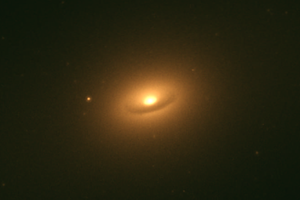NGC 1281
| Galaxy NGC 1281 |
|
|---|---|

|
|
| High-resolution image of the center of NGC 1281, taken with the Hubble Space Telescope | |
| AladinLite | |
| Constellation | Perseus |
|
Position equinox : J2000.0 , epoch : J2000.0 |
|
| Right ascension | 03 h 20 m 06.1 s |
| declination | + 41 ° 37 ′ 48 ″ |
| Appearance | |
| Morphological type | E5 |
| Brightness (visual) | 13.8 mag |
| Brightness (B-band) | 14.8 mag |
| Angular expansion | 0.9 ′ × 0.4 ′ |
| Position angle | 66 ° |
| Surface brightness | 12.8 mag / arcmin² |
| Physical data | |
| Affiliation | Abell 426 |
| Redshift | 0.014343 +/- 0.000040 |
| Radial velocity | 4300 +/- 12 km / s |
|
Stroke distance v rad / H 0 |
(197 ± 14) · 10 6 ly (60.3 ± 4.2) Mpc |
| history | |
| discovery | Johan Dreyer |
| Discovery date | December 12, 1876 |
| Catalog names | |
| NGC 1281 • PGC 12458 • CGCG 540-108 • MCG + 07-07-067 • 2MASX J03200610 + 4137483 • 2XMM J032006.4 + 413751 • LDCE 224 NED209 | |
NGC 1281 is an elliptical galaxy of Hubble type E5 in the constellation Perseus in the northern sky . It is an estimated 197 million light years away from the Milky Way , has a diameter of about 50,000 ly, and is a member of the Perseus Cluster Abell 426 .
In the same area of the sky are u. a. the galaxies NGC 1274 , NGC 1277 , NGC 1278 , NGC 1279 .
The object was discovered by Johan Dreyer on December 12, 1876 .
Web links
Commons : NGC 1281 - collection of images, videos, and audio files
